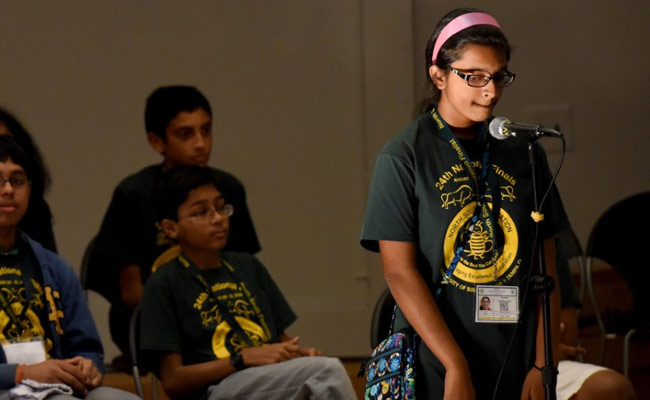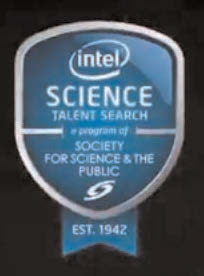
Tampa, Florida: There were no streams of confetti when the winner spelled her final word at the North South Foundation spelling bee.
Unlike the glamorous Scripps National Spelling Bee, no trophy was handed out. The top 12 spellers faced off in a lecture hall with seating for 200, not a ballroom with space for thousands. When competitors missed a word, they didn’t retreat to a “crying couch” to commiserate with their families and do TV interviews before an audience of millions. They just shuffled off stage and sat in the crowd. Instead of $45,000 in cash and prizes, the winner got $500.
Yet it’s likely that next year’s National Spelling Bee champion spent a Saturday in August at the North South Foundation’s national finals.
The last dozen winners of spelling’s biggest prize have been Indian-Americans who share more than heritage. Every single one has participated in bees staged by the nonprofit foundation, which was launched in 1989 to raise scholarship money for poor kids in India.
Among the many reasons for Indian-Americans’ dominance of spelling, perhaps none is as important as the training and competitive experience they get from the foundation, where many participants start as early as first grade. The foundation organizes one of two national spelling bees exclusively for kids with South Asian heritage.
“The National Spelling Bee is the major leagues. We’re the minor league feeding into the major leagues,” NSF founder Ratnam Chitturi said.
He launched the spelling bee as a way to serve children of Indians who immigrated to the United States. Now the foundation also has competitions in other subjects, including math, science, vocabulary, geography, public speaking and essay writing. The last five winners of the National Geographic Bee also honed their skills in NSF competitions.
But they are not open to children without Indian heritage. Chitturi said he fields one or two requests a year from parents who seek to enroll children of other ethnicities. The all-volunteer organization simply lacks the resources to host bees for everyone, he said.
More recently, another high-stakes bee has emerged: the South Asian Spelling Bee, which launched in 2007 and has its national finals every year at Rutgers University in New Jersey. It carries a substantial cash prize – $10,000 for the winner – and some spellers believe the words are even tougher than those used at the National Spelling Bee.
Paige Kimble, the longtime executive director of the National Spelling Bee, said she has not heard any complaints that Indian-Americans have an unfair advantage because they come up through the minor-league bee system. Two decades ago, she fielded questions about whether home-schooled kids had an edge, a controversy that has largely faded.
“We heard far more concerns then about fairness, and we just don’t hear that now,” Kimble said. “What I would say is the edge goes to the individual, regardless of heritage, who works the hardest.”
The emergence of the NSF and South Asian bees reflects the importance that Indian-American families place on academic achievement, said Sanjoy Chakravorty, a professor of geography and urban studies at Temple University and the co-author of an upcoming book, “The Other One Percent,” about the wealthy, highly educated Indian-American community.
The emphasis on rote memorization in the Indian education system creates a level of comfort for parents who coach their kids for spelling contests, Chakravorty said. And because the community does not place a great emphasis on sports, Indian-Americans have a potential advantage over kids who pursue a wide range of activities.
Spelling bees require concentration and poise, the ability not to freeze in pressure situations. It’s at NSF where participants learn the techniques of top spellers. They take their time, repeating the word several times and asking for the definition, the part of speech and the language of origin.
This year’s National Spelling Bee co-champion, Nihar Janga, took the title in his first attempt at age 11. But he started with NSF in kindergarten and finished second in last year’s bee.
“I gradually built up all that confidence and poise on stage,” Nihar said. “NSF prepared me because it was really competitive.”
The high level of competition also creates some intense rivalries. This year’s NSF bee was the last of many duels between the top two finishers.
Two years in a row, Ananya Kodali and Smrithi Upadhyayula went head-to-head at the Scripps regional bee in Dallas, and both times, Smrithi came out on top.
Smrithi went on to finish fifth at the National Spelling Bee. She believes Ananya could have fared just as well. But Ananya never got the chance.
“In the beginning, I was kind of bitter, like, ‘Why didn’t I get to make it? I’m sure I’m as good as those people up there,'” Ananya said. “But I’ve kind of accepted it.”
Both girls were about to start ninth grade when they squared off for the NSF title in August on the University of South Florida campus. That meant the bee would be their last.
This time, the words were kinder to Ananya. After Smrithi stumbled on “stigmonose,” a disease in plants, Ananya sealed the title with “glace,” which means having a smooth, glassy surface. The crowd saluted her with a standing ovation.
Ananya also finished second at the South Asian Spelling Bee – twice, including this year, when she beat Smrithi in the regionals.
The spelling bee wasn’t Smrithi’s only competition that day.
“I also did the vocabulary bee afterwards,” she said.
And how did she fare?
“I won it.”





Be the first to comment